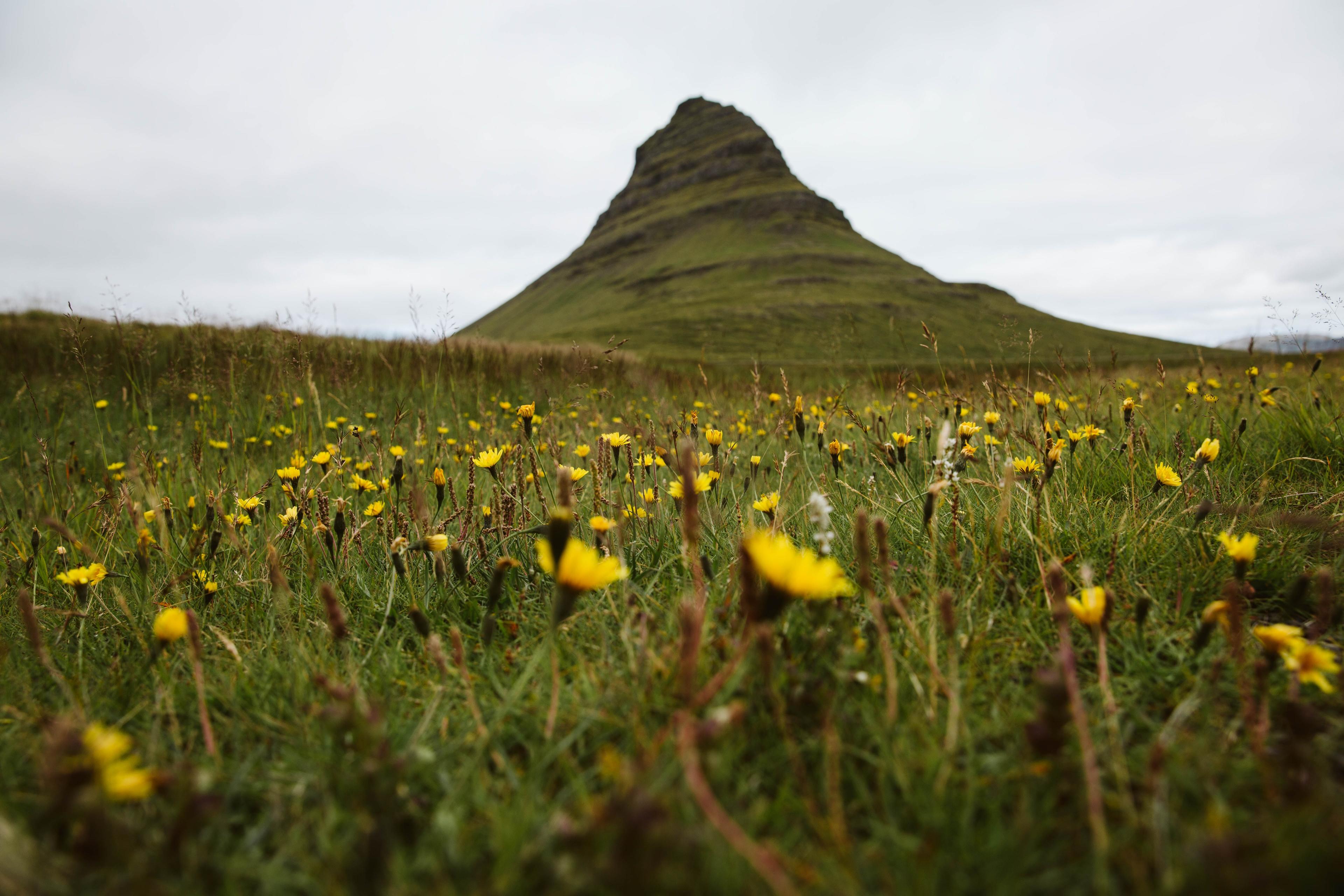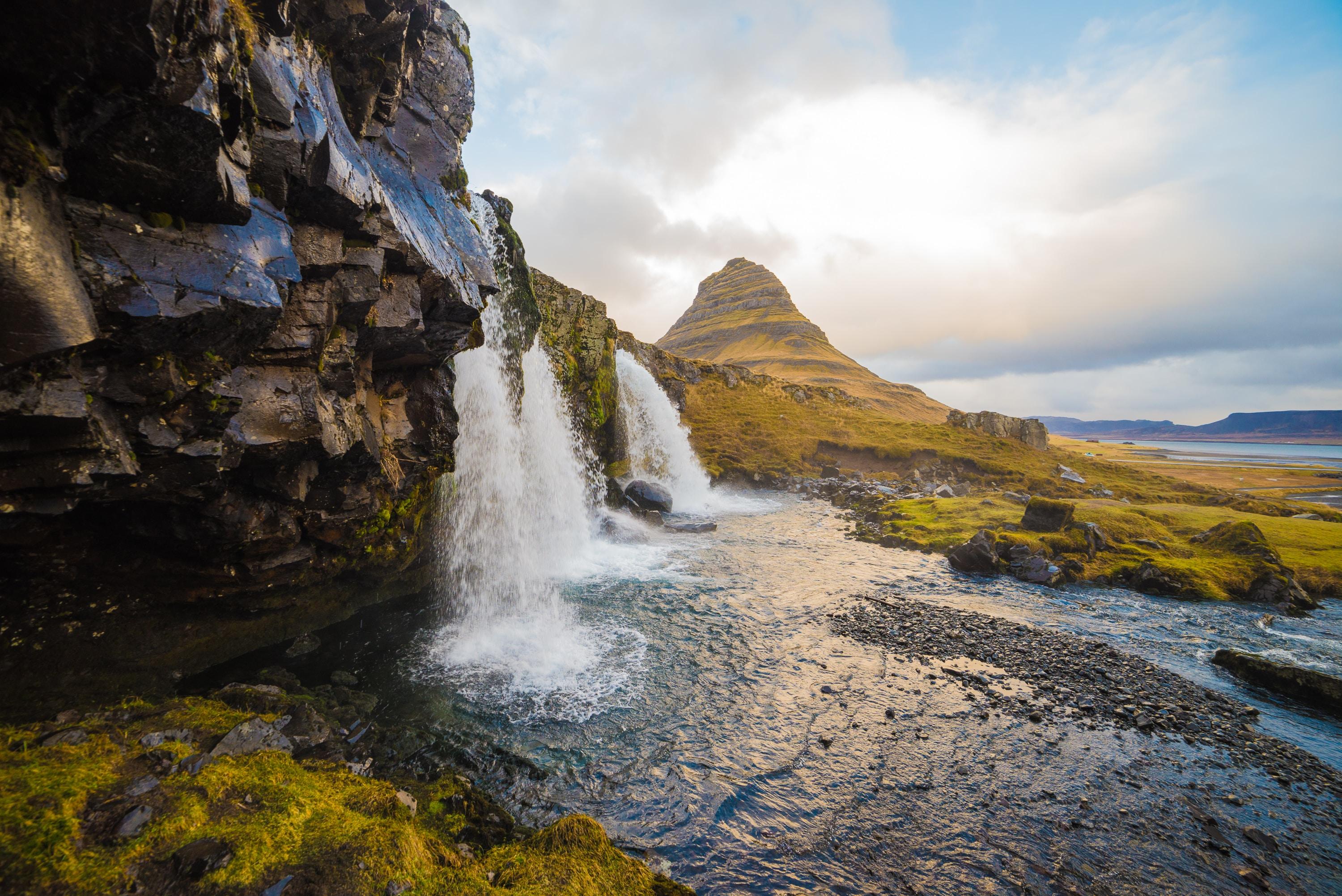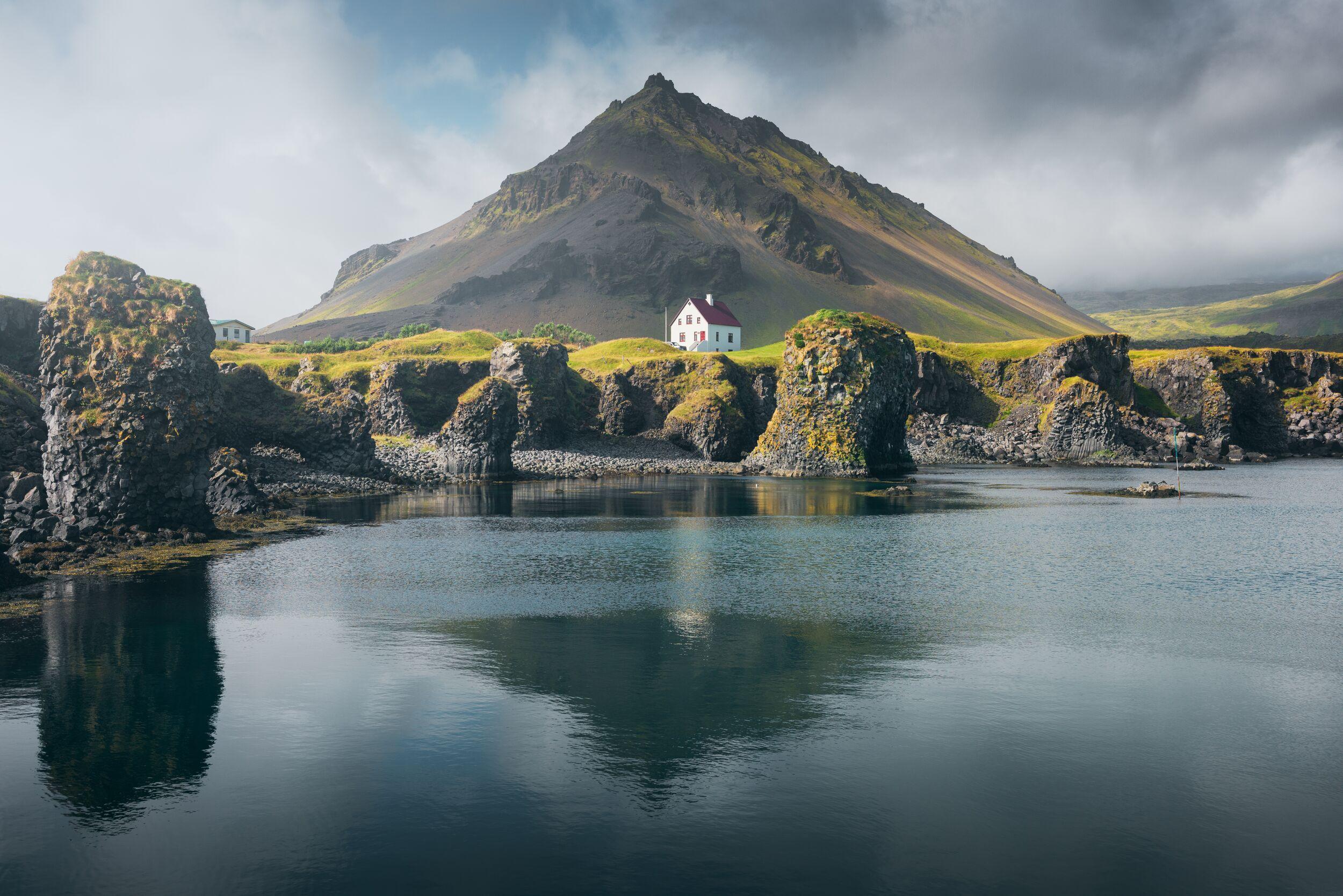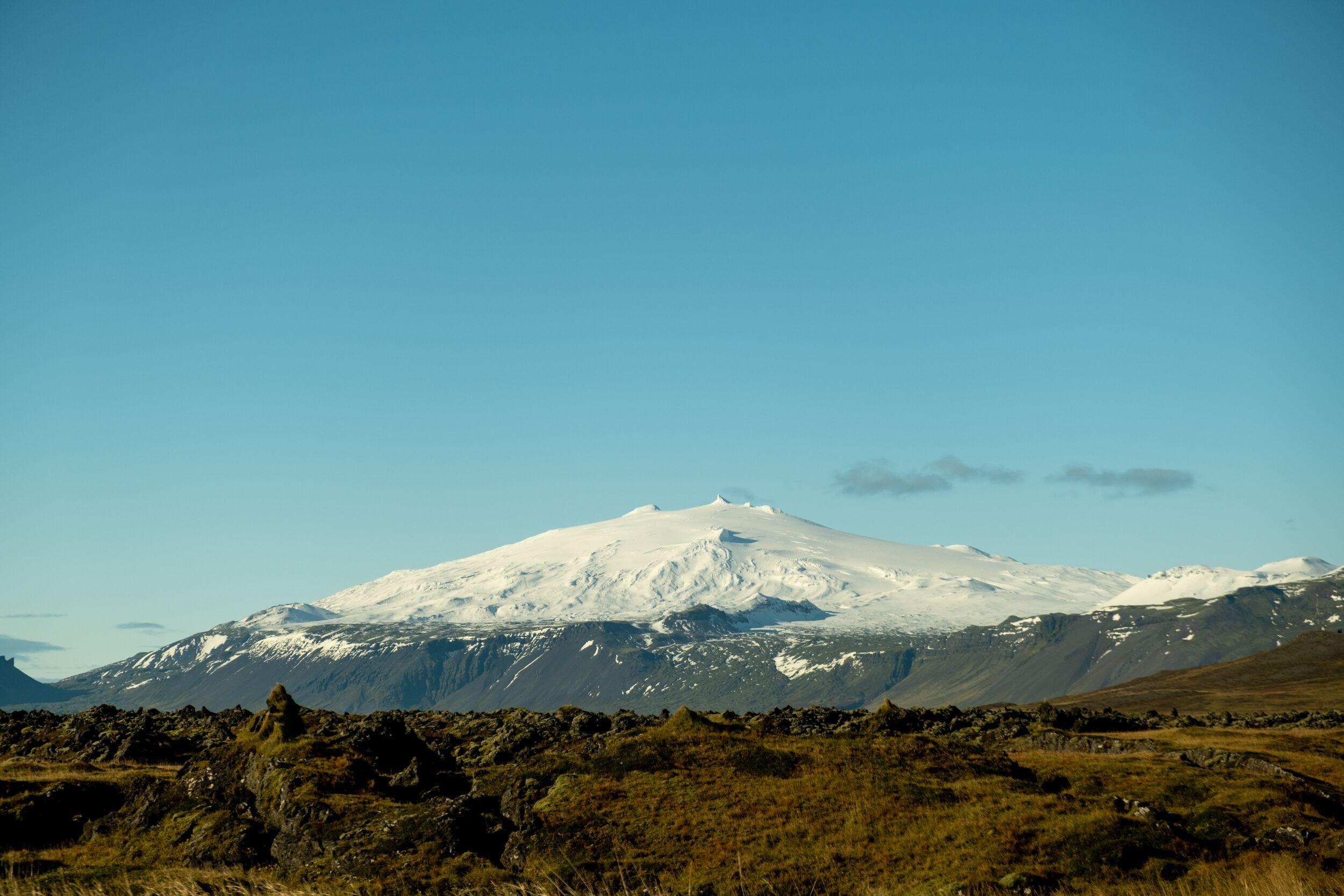
- Best time to visit
- All year round
- Coordinates
- 64.94195, -23.30600
- Distance from Reykjavík
- 178km (110mi)
What to know about Kirkjufell, Iceland
The history of the “Church Mountain”
While it’s most famously known as “Church Mountain”—Kirkjufell in Icelandic—this mysterious peak has other names. Some call it the “witch’s hat”, while early Danish sailors dubbed it Sukkertoppen, or “The Sugar Top”.
Whichever name you prefer, Kirkjufell stands out from most other mountains in Iceland. This is because it would once have been what geologists term a nunatak or glacial island: a mountain whose summit poked out from a surrounding ice cap. Picture a vast expanse of ice with only Kirkjufell’s rocky peak emerging.
Why did this form? Iceland's volcanic activity plays a part. In the past, a volcanic eruption would have spewed molten rock that formed the bulk of Kirkjufell. Since this occurred beneath a glacier, the rock cooled rapidly, resulting in the mountain’s unique jagged summit.
Over time, the encasing ice smoothed the mountain's gentler slopes. However, being composed of harder volcanic rock than its surroundings, Kirkjufell resisted erosion more effectively. This left us with a distinct steep-sided mountain in an otherwise relatively flat landscape.

What to do on a visit to Kirkjufell
If you’re visiting the Snæfellsnes peninsula, you’ll want to stop off at Kirkjufell. Undoubtedly, it's one of the most impressive sights in western Iceland.
A popular activity is the Kirkjufell hike. During summer or in favourable weather, a short walk around the mountain is truly enjoyable. However, attempting to reach the summit is advisable only for experienced mountain climbers equipped with the proper gear, including ropes. Tragically, there have been fatalities on this mountain due to visitors venturing beyond their capabilities.
Luckily, there is an alternative Kirkjufell hike to do. You can hike a loop of the small peninsula on which the mountain sits, giving you incredible views of the mountain from all sides. This coastal path is about 6.5 kilometres (4 miles) and can be completed in less than 2 hours.
Of course, you shouldn’t miss some of the iconic Kirkjufell viewpoints either. Park up at the Kirkjufellsfoss car park and you’ll be able to see the famous mountain from the magical waterfalls. It’s a truly picturesque scene.

How to get to Kirkjufell
To visit Kirkjufell you have a lot of travel options. For example, you could visit on a self-drive tour of Iceland, or on a guided group tour of Snæfellsnes peninsula. The choice is yours.
One of the most popular ways to see Iceland is to hire a car. It’s definitely a convenient way to see Iceland at your own pace. Kirkjufell and its surroundings have ample parking, and it’s about a 2.5-hour drive from Reykjavík.
Heading north on route 1 from the capital, take route 54 after Borgornes in the direction of Snæfellsnes. After a short distance, route 56 will keep you heading north to rejoin the route 54 on the north side of the peninsula, where you can head west to Grundarfjörður and Kirkjufell.
That said, not everyone wants to drive. When you’re in an unfamiliar country with famously volatile weather, that’s understandable. It can be a lot more relaxing to skip the hassle of driving and navigating and join a guided tour to Kirkjufell instead.
For instance, see Kirkjufell alongside the other wonders of Snæfellsnes. The peninsula is often referred to as “Iceland in miniature” thanks to its high concentration of breathtaking sights—from the icy expanse of the Snæfellsjökull to the cliffs and black-sand beaches around Arnarstapi. In fact, much of the peninsula is a national park, Snæfellsjökull, one of only three in Iceland. You can explore it all and more in a day trip from Reykjavík.
Alternatively, get in touch for a trip that’s tailor-made for you. Whether you want to combine a trip to Snæfellsnes with an active adventure in the highlands, or you have something else in mind entirely, we can help make it happen.
All About Kirkjufell
Kirkjufell is 463 metres (1,519 feet) high and the path to climb it starts from the car park at the side of the road 54. While it’s a very direct route up to the top of the mountain, it is a climb so only seasoned mountain climbers with the appropriate equipment, such as ropes, should consider ascending to the summit. Sadly, this mountain has witnessed fatalities when individuals overestimated their climbing abilities.
Kirkjufell is known as the most-photographed mountain in Iceland. While there’s no way of knowing whether that’s true, there’s no doubt that it’s a truly iconic mountain.
You’ll understand why when you see it. Kirkjufell’s magnificent ridge towers over the surrounding coastal landscape. In fact, its name, “Church Mountain” is inspired precisely by this imposing form. Kirkjufellsfoss, the magical waterfall close by, adds an extra dimension to this spectacular view.
And to give it an extra star quality, Kirkjufell also appeared in Game of Thrones, in which its known as the Arrowhead Mountain.
Kirkjufell is one of Iceland’s most iconic sights. From a distance, its unique shape rises abruptly from the surrounding landscape. From the top, it offers breathtaking views of the sea and land.
If you’re an outdoor enthusiast, a trip up to its summit is an awe-inspiring experience. And if not, Kirkjufell is a splendid photo opportunity when you’re on the Snæfellsnes peninsula.
Tackling Kirkjufell isn't a task to be taken lightly. While the climb is relatively short, the journey is exceedingly steep. It typically requires about 1.5 hours to reach the summit, and the descent follows the same challenging path.
The route up this stark and imposing mountain is not only steep but also alarmingly exposed, necessitating a strong head for heights and nerves of steel. It's crucial to be equipped with proper climbing shoes providing excellent grip - city trainers simply won't suffice on this demanding terrain.
On top of this, please bear in mind that it's not just a challenging hike, it's an actual climb. This means that appropriate climbing gear, including a harness and rope, is absolutely essential for your safety. It isn't a mere walk-up, and it's not suitable for average hikers.
Respect for the weather conditions is crucial. If faced with strong winds and rain, Kirkjufell transforms into an extremely difficult, potentially deadly mountain to climb. Tragically, there have been fatal accidents in the past, which serve as a solemn reminder of the mountain's dangers. If you've begun the climb and feel uneasy, it's always safer to descend than to continue upward.
As a result of these hazards, access to this mountain is now strictly limited. It's only open during the summer months, and even then, it's only recommended for experienced climbers.
You may recognise Kirkjufell from the hit series, Game of Thrones. In the show, it’s known as Arrowhead Mountain, a key landmark behind the Wall.
The atmospheric location is supposed to be the birthplace of the Night King and it can be seen in season 6.
Kirkjufell is the sole peak on a little peninsula that juts out into the Breiðafjörður, the fjord that separates Snæfellsnes from the Westfjords. You can walk around this peninsula on a coastal path, giving you excellent views of Kirkjufell from every angle.
The circular trail from the car park is about 6.5 kilometres (4 miles) and can be completed in under 2 hours.
You don’t need to pay to see Kirkjufellsfoss itself, but you will need to pay for parking. That costs 700 ISK.
Alternatively, you can forget about the car and join a tour of the Snæfellsnes peninsula instead. We’ll take you to all of the highlights of the peninsula, including Kirkjufell, Arnarstapi village, and the mighty Snæfellsjökull glacier.
Kirkjufell is pronounced more or less how it’s written in English. There are just a few things to look out for if you want to get the Icelandic pronunciation exactly right.
Firstly, pronounce the “i” in “kirk” like an “i” sound, rather than “u” you might use in English. Then soften the “j”, so it is more like a “y”. Finally, the double-L in Icelandic is usually pronounced more like “tl”, with a soft T sound.
Kirkjufell reaches a height of 463 metres (1,500 feet) above sea level. To reach the summit, the path starts at sea level.
There are three different car parks at Kirkjufell and Kirkjufellsfoss. All of them charge for parking. You can expect to pay 700 ISK to leave your car there. That’s equivalent to about 5 US dollars.
Kirkjufell was a nunatak, a mountain peak that would have once emerged through the surface of a surrounding glacier. If you see photos of nunataks, you’ll notice their summits poking through the ice. In the case of Kirkjufell, the peak was eroded by two separate glaciers.
Typically, nunataks are formed because they are harder and more resistant to erosion than surrounding rocks. For example, Kirkjufell contains volcanic rock which was better able to withstand the glacial erosion.
Kirkjufell is one of the best-known mountains in Iceland. Here are some key facts that you should know:
- Firstly, it’s said that Kirkjufell is the most photographed mountain in Iceland. Professional and amateur photographers come to capture its unique shape and its spectacular location next to the ocean.
- Kirkjufell would once have been almost entirely covered by glaciers. Only its irregular top would have emerged from the ice’s surface.
- There’s a local legend of a woman who lived with her two sons on the Kirkjufell farm. When the sons both drowned in Kirkjufellsfoss waterfall when fishing, she cast a spell so that no one would ever drown in the river again—but that no one would ever catch a fish in the river either.
Kirkjufell translates as “Church Mountain”. It’s so named, thanks to its distinctive shape.
However, many say it looks more like a witch’s hat. Meanwhile, Danish sailors originally referred to the mountain as Sukkertoppen, or “The Sugar Top”.
Kirkjufell was formed thanks to an ancient volcanic eruption. The summit of the mountain is made from tuff, a hard volcanic rock that is created when volcanoes erupt beneath glaciers. The rapid cooling of that rock causes its ragged shape.
As a result, the volcanic rock once would have protruded from the top of surrounding ice caps. As the softer rock eroded, we were left with this strange form that rises high above the surrounding landscape.
Related tours

Wonders of Snaefellsnes Peninsula - Small Group Tour
Snaefellsnes peninsula is called "Iceland in Miniature" for a good reason: the region showcases raw beauty, glacier-capped volcanoes, postcard-worthy landscapes, dramatic cliffs, black sand beaches, and charming fishing villages. Yet, unlike other popular day trips from Reykjavík, it offers something rare: solitude. With fewer visitors, it’s the ideal escape for those seeking Iceland’s breathtaking scenery without the crowds.

Icelandic Wellness Package - 6-Day
Golden Circle, Blue Lagoon, Reykjavík Food Walk, Snæfellsnes. Relax, recharge, and explore Iceland’s most stunning natural wonders with this 6-day (5-night) Icelandic Wellness package. This tour blends ultimate relaxation with breathtaking landscapes, Icelandic flavors and seamless travel with carbon-neutral transportation and expert local guides.

Snæfellsjökull Summit Hike
This is a thrilling one-day hike to the summit of Snæfellsjökull glacier, the crown jewel of the Snæfellsnes Peninsula. This challenging journey rewards hikers with breathtaking views, fascinating geological formations, and the triumphant feeling of conquering one of Iceland's most picturesque glaciers.

